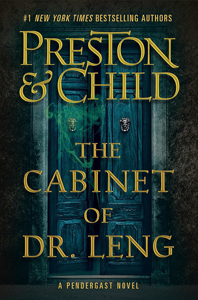Douglas Preston and Lincoln Child have sent Agent Pendergast and other characters to many parts of the globe, but for “The Cabinet of Dr. Leng” (January, hardcover) they explore another dimension: time. At the end of “Bloodless” (2021), Constance Greene takes a time machine from the basement of an old hotel in Savannah to 1880 New York, setting the stage for this sequel. (SPOILERS FOLLOW.)
Rooted in character
The 21st Pendergast novel is an exercise in creating verisimilitude. In a way, it’s helped because the ending of “Bloodless” (wherein monsters from another dimension invade coastal Georgia) is so crazy that Constance’s journey is straightforward by comparison. She goes to a time and place familiar to historians, the authors and the character herself.
The 150-year-old version of Constance – who is physically in her 20s thanks to the serum of Dr. Enoch Leng — aims to kill Leng, who had killed her older sister Mary and had then experimented (successfully) on Constance. Because we meet him in his element, Leng stands out as P&C’s creepily layered answer to Jack the Ripper, although I expect more twisted things from him in the next novel.

“The Cabinet of Dr. Leng” (2023)
Authors: Douglas Preston and Lincoln Child
Series: Agent Pendergast No. 21
Settings: 2023 and alternate 1880, New York City
The scientific/technological verisimilitude for the dimension hopping is provided by a new character, Ferenc. He’s a prickly genius who fixes the time machine in exchange for piles of cash.
Pendergast’s trusted assistant Proctor is more front-and-center than usual, his crisp military brutalism rubbing Ferenc the wrong way. It’s an entertaining rivalry, as both are needed to operate the machine, which has been transported to the tunnels beneath the agent’s Riverside Drive mansion. Ferenc ends up in one of those increasingly wild side plots like Agent Coffey’s in “Dance of Death” (2005). We may not like Ferenc nor sympathize with his get-rich-quick scheme, but the price he pays for his arrogance is creatively horrifying.
It’s one of those fast-escalating “can’t look away” sequences, but more than pitch-black humor, it illustrates the villainy of Leng and the scariness of 1880 society to an observer from our comparatively civilized times. Also illustrated via a comparison of the haves and have-nots (which includes the trio of street-dwelling Greene siblings), “Dr. Leng’s” stark portrayal of a casually inhumane past reminds me of Michael Crichton’s “Timeline.”
Revenge is a dish best served cold
While the time and place are thoroughly rendered, Constance’s reason for going there is under-developed. Essentially — as we surmise via Pendergast’s surmising, rather than Constance’s own thoughts – she is driven through sheer vengeance to kill Leng and through heedless love to rescue Mary, Joe and her own younger self (nicknamed Binky). They are living on the freezing December streets in the slums of New York — such a bad lot in life that being in Leng’s sights makes matters only marginally worse.

Pendergast, Constance and everyone else – even the reckless Ferenc – knows “time machine” is a misnomer. The portal-generating device actually sends everyone to an alternate 1880. What they do in this alternate dimension won’t have any impact on “our” 2023. (A reference in the book does set it in 2023. This is a little surprising, as I hadn’t thought Pendergast’s adventures stretch from 1995 to present day in real time. I thought maybe they covered 15 years.)
This alternate dimension in the multiverse pre-exists; it’s not a branch created by Constance’s appearance. This is different from most movie time-travel narratives, such as “The Terminator” and “Back to the Future.”
Constance sorrow
While we don’t get much inner turmoil from Constance, that’s not necessarily out of character. Once she sets her mind to something – including revenge, as seen in the Diogenes books – she discards doubts. Here, she is driven to set herself up as a transplanted European duchess. The way she achieves this — courting allies and tricking societal movers-and-shakers — is entertaining.
The downside is that we don’t learn if she’s bothered by the fact that she can’t rescue the Greenes from her own past – nor from an infinite number of other timelines in the multiverse.
Maybe she simply doesn’t let her mind go there. A case could be made that Constance’s quest is a selfish one for the sake of soothing her own psyche. If all goes according to plan, she will rescue one trio of siblings on one timeline, and kill one evil person on one timeline, and that’s not nothing. But it’s not the reason she’s doing it.
Pendergast’s desire to follow her through the wormhole is also underexplored, albeit in an intriguing way. He aims to rescue Constance from herself, but he knows she’ll fly into a rage if she learns he has interfered. Pendergast creates tension with his stated goal: He and D’Agosta are to oversee and manipulate Constance without her realizing it.
Multiple assistants
“Dr. Leng” also peppers in a Coldmoon case – on which D’Agosta helps, thus bringing two of Pendergast’s sidekicks together, and allowing for an amusing conversation over beers. Coldmoon goes to the Black Hills of South Dakota and we get some of that western flavor enjoyed by New Mexico resident Preston.
How Coldmoon’s and D’Agosta’s case of stolen Lakota artifacts from the New York Museum of Natural History relate to Dr. Leng is unclear. Still, I’m intrigued.
Ultimately, “Dr. Leng” has more setup than payoff, prompting an apologetic author’s note at the end where P&C promise the conclusion of the Leng Quartet — “The Cabinet of Curiosities” (2002), “Bloodless,” “Dr. Leng” and the next one — will be worth the wait.
This novel doesn’t have as much of a horror vibe as you might expect when a mad scientist/serial killer is the title character. But it does – despite being about multi-dimensional travel – ground the story with excellent writing about what life was (“is”) like in 1880 New York, plus its personal nature for Constance and, by extension, Pendergast (and by further extension, D’Agosta and Coldmoon).
After the too-fanciful “Bloodless,” “The Cabinet of Dr. Leng” is satisfying in a more down-to-earth way. Even if it’s not strictly this Earth.

